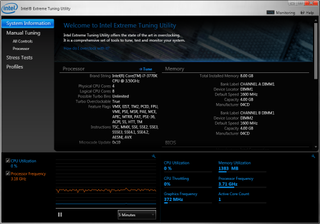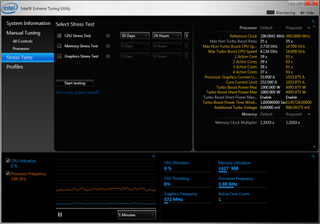Seven Sub-$160 Z77 Express Motherboards, Reviewed
Intel’s LGA 1155 interface is designed for mainstream buyers, yet the firm’s Ivy Bridge-based processors put it in the performance spotlight. We compare seven Z77 Express motherboards that deliver enthusiast-class performance at mainstream prices.
Overclocking With Intel Extreme Tuning Utility
Intel doesn’t seem to want you to use its Extreme Tuning Utility. How else could we explain why it isn’t mentioned in the motherboard’s software suite, or referred to on the motherboard’s product page? How else could we explain why it isn’t even listed as compatible for recent motherboards, or that motherboards are only added to its list after they’ve fallen out of our spotlight?
XTU is likely intended for “in the know” overclocking exhibitionists and members of the press who usually get their hardware long before our round-ups are published. Most end-users are forced to search for it, and the lack of references to the name makes that search even more difficult.


XTU’s system information tab provides basic information about your software and hardware configuration, but lacks most of the status readings found in its Desktop Utilities application. The pair might be complementary.


Manual Tuning controls primarily focus on increasing the power ceiling for overcurrent protection, with voltage increases limited to Additional Turbo Voltage. We're showing everything maxed out, but the only part of the program we really used was its base clock controls. We’ll discuss the reason for this on the next page.

Intel has its own stress-testing program, which many professional-level overclockers use to prove that their systems are stable.

As in the UEFI, a complete set of XTU values can be saved as an overclocking profile.
Stay on the Cutting Edge
Join the experts who read Tom's Hardware for the inside track on enthusiast PC tech news — and have for over 25 years. We'll send breaking news and in-depth reviews of CPUs, GPUs, AI, maker hardware and more straight to your inbox.
Current page: Overclocking With Intel Extreme Tuning Utility
Prev Page DZ77SL-50K Applications Next Page DZ77SL-50K UEFI-
Crashman SpadeMLAN performance .. ISC performance ... USB 3 .. well that's it then.Tom's Hardware has several controller comparisons, and publishes new ones frequently. So unless you think one of the boards has a broken controller, wysiwyg.Reply
The things that actually get screwed-up are typically related to the clock generator, multiplier control, memory timings and power options. -
jaquith I always appreciate your Articles! :) I know how much work you do to get them done.Reply
You're kidding - Biostar. I guess this article is not about the 'Best Sub-$160 Z77' MOBO's but about the best manufacturers sent you. The cheapest MOBO I recommend for the SB/IB (K) is the ASUS P8Z77-V which pops your 'unique' budget cap depending where you shop; found it here for $159.99 - http://www.gadgetneeds.net/asus-p8z77-v-atx-intel-motherboard/
Interesting you didn't get an ASUS P8Z77-V LK ~$120 which offers SLI. The ASRock Z77 Extreme4 and Gigabyte Z77X-D3H for the price aren't bad.
There's NO WAY I'm recommending Biostar in the forum, folks and myself would thing I've lost my mind. -
Crashman jimishtarIt would be nice to see the CPU voltage for every board when overclocking.1.25VReply -
gorillagarrett No peripherals performance tests? Those are the only tests that differentiate those motherboards from each other.Reply
Would really like to see how the UD3X Atheros Ethernet controller fares against the Intel and broadcom ones. -
Crashman gorillagarrettNo peripherals performance tests? Those are the only tests that differentiate those motherboards from each other. Would really like to see how the UD3X Atheros Ethernet controller fares against the Intel and broadcom ones.I'll let the integrated controller guy know you'd like to see those parts compared :)Reply -
gorillagarrett ReplyI'll let the integrated controller guy know you'd like to see those parts compared
Thank you! -
rolli59 I would have liked to see the Asus P8Z77V-LK version instead of the LX since it is better equipped.Reply
Most Popular


